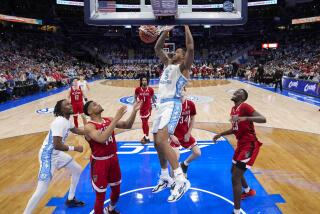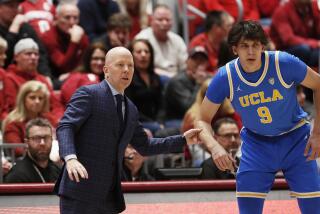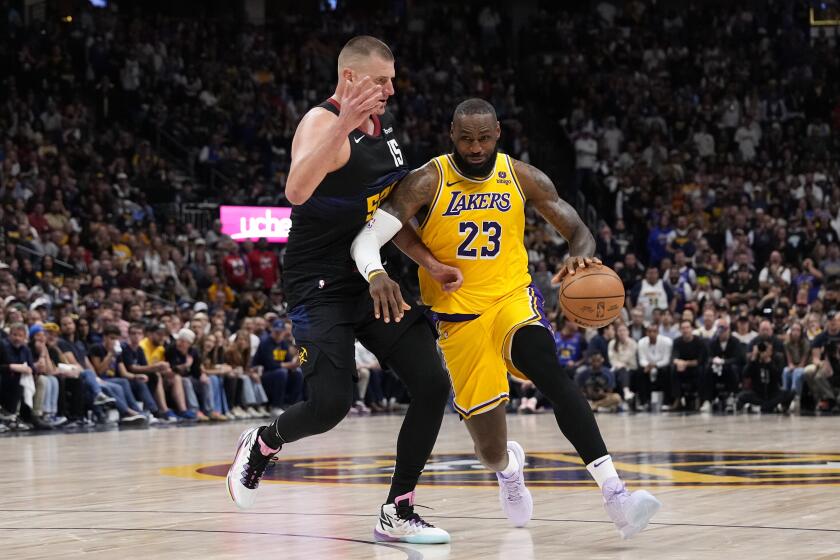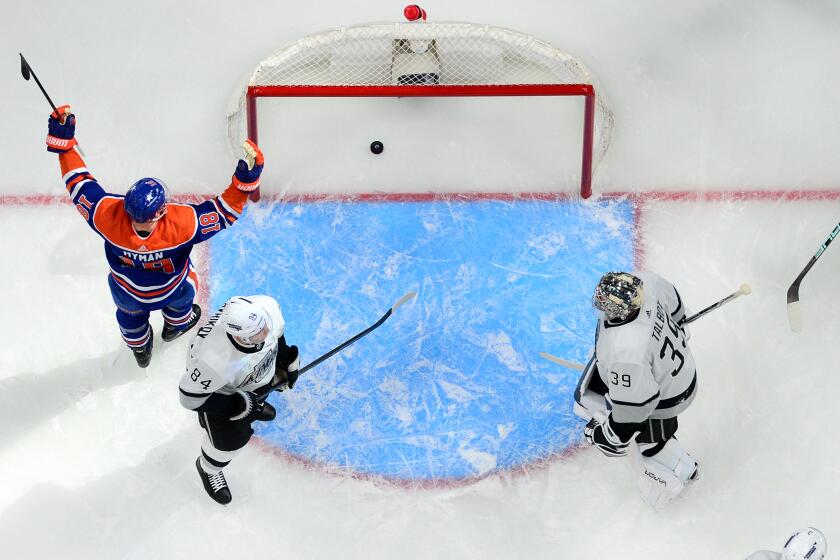After a chaotic, unpredictable season in college basketball, March could be madder than ever
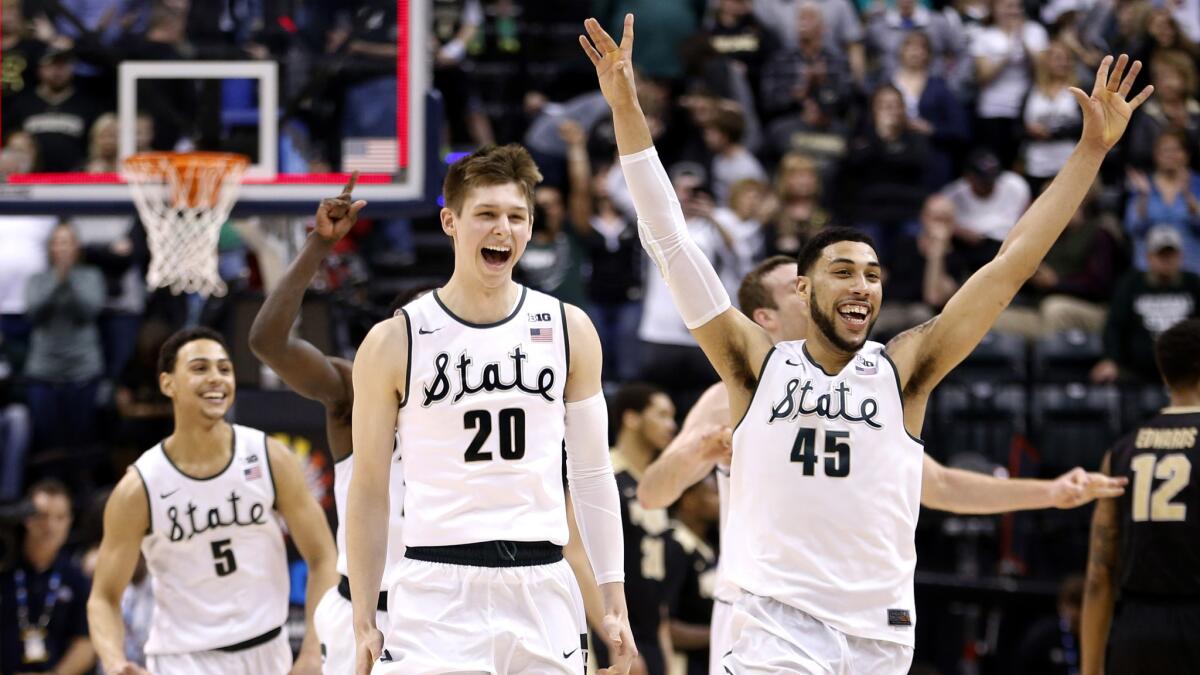
Michigan State players celebrate after defeating Purdue in the Big Ten Conference tournament championship game Sunday.
There are plenty of theories about the chaos that has descended upon college basketball this season.
The new 30-second shot clock might be to blame. Or it could a shift in officiating.
With six different teams having occupied the No. 1 spot in the Associated Press media poll since November, some fingers have pointed at an unpredictable freshman class.
Only one thing seems certain:
When the NCAA tournament starts this week, March should be madder than ever.
“It’s a bizarre year,” Michigan State Coach Tom Izzo told reporters. “It’s got everybody screwed up, from writers to coaches to players to fans.”
The tournament has always been unpredictable — that’s a big part of its appeal.
The single-elimination format lends itself to upsets, hot streaks and unlucky bounces. No top-seeded team has ever lost a first-round game, but there have been a few close calls and second- and third-seeded teams that have stumbled.
Several trends in the game could make the traditional powerhouses even more vulnerable when play begins later this week. Just look at what happened during the regular season.
The revolving door at No. 1 included North Carolina, Kentucky, Michigan State, Kansas, Oklahoma and Villanova. No one could hold onto the top spot for more than a few weeks at a time.
Joe Castiglione, chairman of the NCAA’s tournament selection committee, points out this happened only once before in the history of the weekly rankings. And, he says, “the madness goes much deeper than just the top of the poll.”
A regular season filled with upsets gave way to conference tournaments in which more than a dozen No. 1 seeds fell last week. Basketball statistician Ken Pomeroy wonders if the new shot clock — shortened by five seconds — might explain some of the parity.
With less time to hold onto the ball, possessions have increased by an average of four per team per game, he said. That may not sound like much, but it can make a difference in the closing minutes.
“It allows for the possibility of more comebacks,” said Pomeroy, who publishes his analytics on kenpom.com. “It’s harder to take the air out of a game.”
Consider that teams are shooting 35.4% from three-point range this season. The previous high was 34.5% back when the three-point line was a full foot closer to the basket.
A few more looks could make a big difference for a dark horse such as Akron, which ranks second in the NCAA in three-pointers.
Offense got another boost this winter with referees told to blow more whistles for hand-checking.
A similar officiating shift two seasons ago had little effect on scoring. This time around — with the earlier directive re-emphasized — freer movement on the court has produced an average increase of 5.3 points per team.
So Indiana and USC — two of the many teams that are scoring more than a year ago — will be banking on offense at tournament time. After years of headlines bemoaning a steady decline in total points, even the slightest uptick is just what college basketball needed.
“This year is completely wide open,” said Kevin Bradley, sports book manager for the Bovada.lv gaming site. “There could be a lot of teams looming in the middle of the pack.”
Adding to this unpredictability is a freshman class that has not performed to expectations.
The consensus top recruit, Ben Simmons, played well but his Louisiana State team was mediocre and didn’t make the tournament. Other newcomers muddied the waters by turning their backs on the traditional powers.
Jaylen Brown, California’s second-leading scorer with an average of 15.0 points per game, chose the Golden Bears over Kentucky and North Carolina. Caleb Swanigan rescinded a verbal commitment to Michigan State and enrolled at Purdue, where he is averaged 10.3 points and 8.3 rebounds and made the Big Ten’s all-freshman team.
Talent is spread a little more evenly across the country.
“Honestly, 15 to 20 teams are good enough” to win it all, Izzo said.
Gamblers and office-pool players now have an opportunity to guess at which middle-of-the-pack school might catch fire at the right moment. And Las Vegas sports books have a potential nightmare on their hands.
Heading into the weekend, Bovada listed Kansas and Michigan State as co-favorites but Bradley frets over his picks.
“I literally update them every day,” the oddsmaker said. “It’s a stressful thing to do.”
There is still a chance that a traditional powerhouse, such as a healthy Kentucky, will put a conventional ending on this strange season.
But March Madness has a way of messing with the analytics of the game, producing results that just don’t add up. If this year’s heightened volatility holds true to form, a 16th seed might finally defeat a No. 1.
Looking at all the upsets this season — including UCLA’s victory over then-top-ranked Kentucky in December — Izzo doesn’t expect the tournament seeding to mean much.
“A lot of teams are the same,” said the Michigan State coach, whose Spartans are seeded No. 2 in the Midwest Regional. “Never have I seen a year like this.”
Follow David Wharton on Twitter: @LATimesWharton
More to Read
Get our high school sports newsletter
Prep Rally is devoted to the SoCal high school sports experience, bringing you scores, stories and a behind-the-scenes look at what makes prep sports so popular.
You may occasionally receive promotional content from the Los Angeles Times.


